Developing a Culture for Growth—Reflections from the Project Team
error code: 502
Developing a Culture for Growth—Reflections from the Project Team Read More »
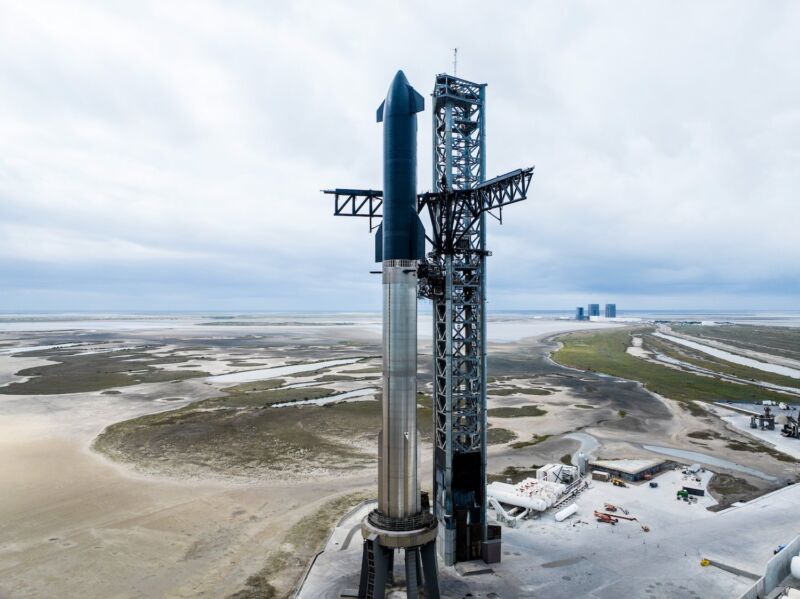
Enlarge / SpaceX’s fully-stacked Starship rocket and Super Heavy booster on a launch pad in South Texas.
One of the largest launch pads at Cape Canaveral Space Force Station will become vacant later this year after the final flight of United Launch Alliance’s Delta IV Heavy rocket. SpaceX is looking to make the sprawling facility a new home for the Starship launch vehicle.
The environmental review for SpaceX’s proposal to take over Space Launch Complex 37 (SLC-37) at Cape Canaveral is getting underway now, with three in-person public meetings and one virtual meeting scheduled for March to collect comments from local residents, according to a new website describing the plan.
Then federal agencies, led by the Department of the Air Force, will develop an environmental impact statement to evaluate how Starship launch and landing operations will affect the land, air, and water around SLC-37, which sits on Space Force property on the Atlantic coastline.
Environmental studies for rocket launch facilities typically take more than a year, so it will be a while before any major construction begins to convert SLC-37 for Starship launches. In this case, federal officials anticipate publishing a draft environmental impact statement by December, then a final report by October 2025.
More immediately, ULA still has one more Delta IV Heavy rocket to launch from SLC-37 in March with a classified spy satellite for the National Reconnaissance Office. Once that launch is complete, ULA will wind down operations at SLC-37, and eventually turn over the facility back to the Space Force, which will look for a new tenant. For several months, industry sources have pointed to SpaceX as the leading contender to take over SLC-37 after ULA is finished with the launch pad.
But that’s not quite a done deal yet. Last year, a senior official at ULA told Ars on background that the company was also interested in maintaining a presence at SLC-37.
ULA’s new Vulcan rocket, which debuted last month and will replace the Delta IV and Atlas V launch vehicles, uses a different launch pad a few miles up the coast from SLC-37. ULA is upgrading and expanding its ground facilities at Cape Canaveral to ramp up the Vulcan launch cadence, and the ULA official told Ars the company may want to continue using a rocket processing hangar just south of the Delta IV launch pad for storage and horizontal processing of Vulcan rockets.
Details are scarce about everything SpaceX wants to do with SLC-37, but officials wrote on the environmental review website that SpaceX would “modify, reuse, or demolish the existing SLC-37 infrastructure to support Starship-Super Heavy launch and landing operations.”
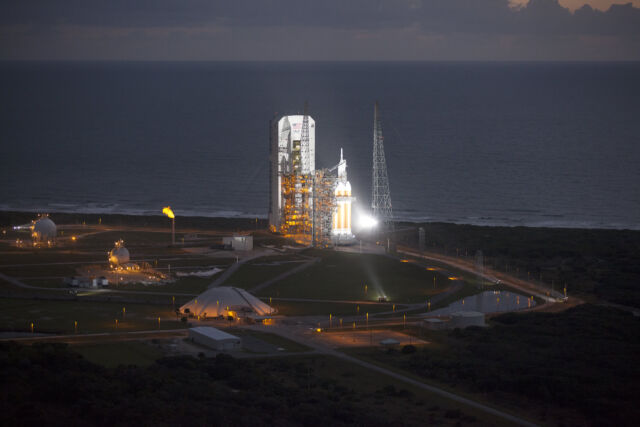
Enlarge / This aerial view shows a United Launch Alliance Delta IV Heavy rocket awaiting liftoff from Space Launch Complex 37 at Cape Canaveral Space Force Station, Florida.
The history of SLC-37 dates back to the 1960s, when NASA used the site for eight flights of the Saturn I and Saturn IB rockets to prepare for the Apollo program. The facility sat dormant for 30 years until Boeing moved in to ready SLC-37 for the Delta IV rocket, which has now flown 34 times from SLC-37. The launch pad currently includes a 330-foot-tall (100-meter) mobile gantry, a fixed erector, a fixed umbilical tower, and a flame trench for Delta IV missions.
Starship, the world’s largest rocket, would not need any of that that infrastructure, so if SpaceX takes over the pad, the facility will likely undergo extensive demolition and construction.
If SpaceX isn’t cleared to use SLC-37, the company could build a brand new launch pad designated Space Launch Complex 50. If this is the path SpaceX takes, SLC-50 would be built on undeveloped land north of SLC-37 and south of SpaceX’s primary launch pad for the Falcon 9 rocket at Space Launch Complex 40.
SpaceX’s interest in setting up shop at SLC-37 shows the company is getting serious about developing a second base for Starship on Florida’s Space Coast. In 2022, SpaceX constructed a launch tower and launch mount for Starship at Launch Complex 39A (LC-39A), located at NASA’s Kennedy Space Center. But the company made little progress there last year as teams focused on Starship test flights from South Texas.
Elon Musk, SpaceX’s founder and CEO, says Starship is the rocket that will make possible his dream of building a settlement on Mars. He has also touted Starship as a vehicle for point-to-point travel on Earth. Both stages of Starship are designed to be fully and rapidly reusable, with the Super Heavy booster and Starship upper stage returning to Earth for propulsive landings. Starship launch pads will double as landing pads.
Before any of those dreams are realized, Starship needs to get into orbit. The first two full-scale Starship test flights last year didn’t make it that far, but SpaceX got close on the second launch in November. SpaceX hopes to achieve a near-orbital mission with the third Starship test launch, perhaps as soon as early March.
Eventually, Musk envisions Starship launching multiple times per day on a variety of missions, carrying people, satellites, cargo, or refueling tankers into orbit. In order to do this, SpaceX will need a lot of launch and landing pads. SpaceX has toyed with the idea of floating offshore launch and landing platforms, but those plans are on hold.
In the near-term, SpaceX plans to build a second Starship launch tower at the company’s Starbase test site in Cameron County, Texas. There’s also the partially-built launch tower at LC-39A, and now SpaceX has set its sights on SLC-37.
SpaceX was previously looking at building another Starship launch pad from scratch on NASA property at the Kennedy Space Center. NASA environmental studies for this location, known as Launch Complex 49, kicked off in 2021. Patti Bielling, a NASA spokesperson, told Ars on Friday the agency is no longer working on Launch Complex 49.
“At this time, there are no activities involving LC-49 on Kennedy,” Bielling said. “Any previous activities regarding LC-49 were suspended, and no actions were taken.”
One of the first operational applications for Starship will be to serve as a human-rated lunar lander for NASA’s Artemis program. SpaceX is developing a version of Starship to ferry astronauts to and from the Moon’s surface, but in order for Starship to reach the Moon, it has to be refueled in low-Earth orbit. This will require perhaps 10 or more refueling flights using a version of Starship called a tanker, all launching in a matter of weeks. Those tanker flights will launch on Super Heavy boosters from pads in Texas and Florida.
In parallel with continued Starship test flights and demonstrating in-space refueling technology, SpaceX needs to build more launch pads to make all this possible. Although SpaceX has backpedaled on several of its Starship launch pad ideas, the company’s interest in SLC-37 suggests it still has big plans for Starship in Florida.
SpaceX wants to take over a Florida launch pad from rival ULA Read More »
Jazmin Locke-Rodriguez and Krishnaswamy Jayachandran, The Conversation –

Enlarge / The cut flowers could pay for themselves and even turn a profit.
Flowers grown on inexpensive floating platforms can help clean polluted waterways, over 12 weeks extracting 52 percent more phosphorus and 36 percent more nitrogen than the natural nitrogen cycle removes from untreated water, according to our new research. In addition to filtering water, the cut flowers can generate income via the multibillion-dollar floral market.
In our trials of various flowers, giant marigolds stood out as the most successful, producing long, marketable stems and large blooms. Their yield matched typical flower farm production.
Water pollution is caused in large part by runoff from farms, urban lawns, and even septic tanks. When it rains, excess phosphorus, nitrogen, and other chemicals wash into lakes and rivers.
These nutrients feed algae, leading to widespread and harmful algae blooms, which can severely lower oxygen in water, creating “dead zones” where aquatic life cannot survive. Nutrient runoff is a critical issue as urban areas expand, affecting the health of water ecosystems.
Water pollution is an escalating crisis in our area of Miami-Dade and Broward counties in Florida. The 2020 Biscayne Bay fish kill, the largest mass death of aquatic life on record for the region, serves as a stark reminder of this growing environmental issue.
We study sustainable agriculture and water pollution in South Florida.
Inspired by traditional floating farm practices, including the Aztecs’ chinampas in Mexico and the Miccosukees’ tree island settlements in Florida, we tested the idea of growing cut flowers on floating rafts as a way to remove excess nutrients from waterways. Our hope was not only that the flowers would pay for themselves, but that they could provide jobs here in Miami, the center of the US cut-flower trade.

Enlarge / Chemical conditions in the test tanks were the same as in nearby polluted waterways.
We floated 4-by-6-foot (1.2-by-1.8-meter) mats of inexpensive polyethylene foam called Beemats in 620-gallon (2,300-liter) outdoor test tanks that mirrored water conditions of nearby polluted waterways. Into the mats, we transplanted flower seedlings, including zinnias, sunflowers, and giant marigolds. The polluted tank water was rich in nutrients, eliminating the need for any fertilizer. As the seedlings matured into plants over 12 weeks, we tracked the tanks’ improving water quality.
Encouraged by the success of the marigolds in our tanks, we moved our trials to the nearby canals of Coral Gables and Little River. We anchored the floating platforms with 50-pound (22.7-kilogram) weights and also tied them to shore for extra stability. No alterations to the landscape were needed, making the process simple and doable.
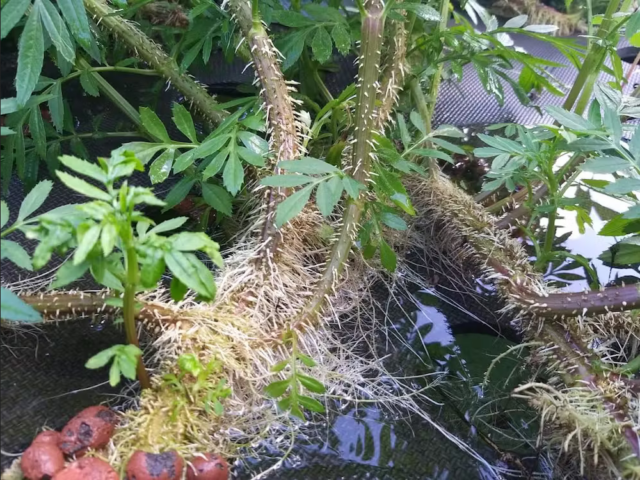
Enlarge / Some plants grow roots in places–such as the stem–other than where their original roots began.
The success of the giant marigolds might be linked to the extra roots that grow from their stems known as adventitious roots. These roots likely help keep the plants stable on the floating platforms. Identifying additional plants with roots like these could help broaden plant choices.
Future raft designs may also need modifications to ensure better stability and growth for other cut-flower and crop species.
Our promising findings show floating cut-flower farms could be a sustainable option for mitigating water pollution.
One of us (Locke-Rodriguez) is expanding this research and working to scale up floating farms in South Florida as a demonstration of what could take place in the many locations facing similar issues worldwide.
The Research Brief is a short take on interesting academic work.![]()
Jazmin Locke-Rodriguez, Post Doctoral Associate in the Institute of Environment, Florida International University, and Krishnaswamy Jayachandran, Professor of Agroecology, Florida International University.
This article is republished from The Conversation under a Creative Commons license. Read the original article.
Flowers grown floating on polluted waterways can help clean up nutrient runoff Read More »

Getty Images
More than 1,000 Ubiquiti routers in homes and small businesses were infected with malware used by Russian-backed agents to coordinate them into a botnet for crime and spy operations, according to the Justice Department.
That malware, which worked as a botnet for the Russian hacking group Fancy Bear, was removed in January 2024 under a secret court order as part of “Operation Dying Ember,” according to the FBI’s director. It affected routers running Ubiquiti’s EdgeOS, but only those that had not changed their default administrative password. Access to the routers allowed the hacking group to “conceal and otherwise enable a variety of crimes,” the DOJ claims, including spearphishing and credential harvesting in the US and abroad.
Unlike previous attacks by Fancy Bear—that the DOJ ties to GRU Military Unit 26165, which is also known as APT 28, Sofacy Group, and Sednit, among other monikers—the Ubiquiti intrusion relied on a known malware, Moobot. Once infected by “Non-GRU cybercriminals,” GRU agents installed “bespoke scripts and files” to connect and repurpose the devices, according to the DOJ.
The DOJ also used the Moobot malware to copy and delete the botnet files and data, according to the DOJ, and then changed the routers’ firewall rules to block remote management access. During the court-sanctioned intrusion, the DOJ “enabled temporary collection of non-content routing information” that would “expose GRU attempts to thwart the operation.” This did not “impact the routers’ normal functionality or collect legitimate user content information,” the DOJ claims.
“For the second time in two months, we’ve disrupted state-sponsored hackers from launching cyber-attacks behind the cover of compromised US routers,” said Deputy Attorney General Lisa Monaco in a press release.
The DOJ states it will notify affected customers to ask them to perform a factory reset, install the latest firmware, and change their default administrative password.
Christopher A. Wray, director of the FBI, expanded on the Fancy Bear operation and international hacking threats generally at the ongoing Munich Security Conference. Russia has recently targeted underwater cables and industrial control systems worldwide, Wray said, according to a New York Times report. And since its invasion of Ukraine, Russia has focused on the US energy sector, Wray said.
The past year has been an active time for attacks on routers and other network infrastructure. TP-Link routers were found infected in May 2023 with malware from a reportedly Chinese-backed group. In September, modified firmware in Cisco routers was discovered as part of a Chinese-backed intrusion into multinational companies, according to US and Japanese authorities. Malware said by the DOJ to be tied to the Chinese government was removed from SOHO routers by the FBI last month in similar fashion to the most recently revealed operation, targeting Cisco and Netgear devices that had mostly reached their end of life and were no longer receiving security patches.
In each case, the routers provided a highly valuable service to the groups; that service was secondary to whatever primary aims later attacks might have. By nesting inside the routers, hackers could send commands from their overseas locations but have the traffic appear to be coming from a far more safe-looking location inside the target country or even inside a company.
Similar inside-the-house access has been sought by international attackers through VPN products, as in the three different Ivanti vulnerabilities discovered recently.
DOJ quietly removed Russian malware from routers in US homes and businesses Read More »

jay_zynism via Getty
For nearly a year now, a bizarre heating event has been unfolding across the world’s oceans. In March 2023, global sea surface temperatures started shattering record daily highs and have stayed that way since.
You can see 2023 in the orange line below, the other gray lines being previous years. That solid black line is where we are so far in 2024—way, way above even 2023. While we’re nowhere near the Atlantic hurricane season yet—that runs from June 1 through the autumn—keep in mind that cyclones feed on warm ocean water, which could well stay anomalously hot in the coming months. Regardless, these surface temperature anomalies could be triggering major ecological problems already.

“In the tropical eastern Atlantic, it’s four months ahead of pace—it’s looking like it’s already June out there,” says Brian McNoldy, a hurricane researcher at the University of Miami. “It’s really getting to be strange that we’re just seeing the records break by this much, and for this long.”
You’ll notice from these graphs and maps that the temperature anomalies may be a degree or two Celsius warmer, which may not sound like much. But for the seas, it really is: Unlike land, which rapidly heats and cools as day turns to night and back again, it takes a lot to warm up an ocean that may be thousands of feet deep. So even an anomaly of mere fractions of a degree is significant. “To get into the two or three or four degrees, like it is in a few places, it’s pretty exceptional,” says McNoldy.
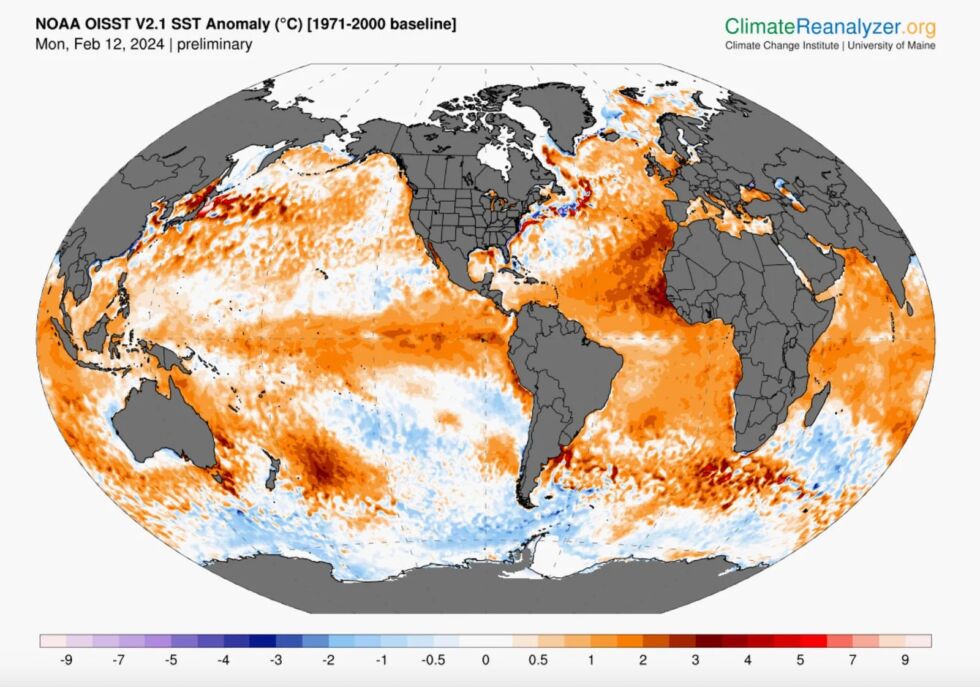
University of Maine
So what’s going on here? For one, the oceans have been steadily warming over the decades, absorbing something like 90 percent of the extra heat that humans have added to the atmosphere. “The oceans are our saviors, in a way,” says biological oceanographer Francisco Chavez of the Monterey Bay Aquarium Research Institute in California. “Things might be a lot worse in terms of climate impacts, because a lot of that heat is not only kept at the surface, it’s taken to depths.”
A major concern with such warm surface temperatures is the health of the ecosystems floating there: phytoplankton that bloom by soaking up the sun’s energy and the tiny zooplankton that feed on them. If temperatures get too high, certain species might suffer, shaking the foundations of the ocean food web.
Skyrocketing ocean temperatures have scientists scratching their heads Read More »

Enlarge / The upper stage for the first Ariane 6 flight vehicle is seen inside its factory in Bremen, Germany. The upper stage’s hydrogen-fueled Vinci engine is visible in this image.
Welcome to Edition 6.31 of the Rocket Report! Photographers at Cape Canaveral, Florida, noticed a change to the spaceport’s skyline this week. Blue Origin has erected a full-size simulator of its New Glenn rocket vertically on its launch pad for a series of fit checks and tests. Late last year, we reported Blue Origin was serious about getting the oft-delayed New Glenn rocket off the ground by the end of 2024. This is a good sign of progress toward that goal, but there’s a long, long way to go. It was fun to watch preparations for the inaugural flights of a few other heavy-lift rockets in the last couple of years (Starship, SLS, and Vulcan). This year, it’s New Glenn.
As always, we welcome reader submissions, and if you don’t want to miss an issue, please subscribe using the box below (the form will not appear on AMP-enabled versions of the site). Each report will include information on small-, medium-, and heavy-lift rockets, as well as a quick look ahead at the next three launches on the calendar.

Russia launches a classified satellite. On February 9, Russia launched its first orbital mission of the year with the liftoff of a Soyuz-2-1v rocket from the Plesetsk Cosmodrome in the far north of the country. The two-stage rocket delivered a classified satellite into orbit for the Russian military, Anatoly Zak of RussianSpaceWeb.com reports. In keeping with the Russian military’s naming convention, the satellite is known simply as Kosmos 2575, and there’s little indication about what it will do in space, except for one key fact.
But wait, there’s more … It turns out the launch of Kosmos 2575 occurred at exactly the same time of day as another Soyuz-2-1v rocket launched on December 27 with a Russian military satellite named Kosmos 2574. The newer spacecraft launched into the same orbital plane as Kosmos 2574, a strong indication that the two satellites have a shared mission. In recent years, Russia has tested rendezvous, proximity operations, and, at least in one instance, a projectile that would have applications for an anti-satellite weapon. You can be sure the US military and a global community of hobbyist satellite trackers will watch closely to see if these two satellites approach one another. If they do, they could continue technology demonstrations for an anti-satellite system. It’s unclear if the recent revelations regarding US officials’ concerns about Russian anti-satellite capabilities are related to these recent launches.
European startup testing methane-fueled rocket engine. Space transportation startup The Exploration Company has continued testing its methane-fueled Huracán engine, which will power an in-space and lunar transportation vehicle under development, European Spaceflight reports. Most recently, the Huracán engine completed another round of thrust chamber testing using liquid methane fuel as a coolant and tested a new thermal barrier coating. The methane/liquid oxygen engine is undergoing testing at a facility in Lampoldshausen, Germany, ahead of use on The Exploration Company’s Nyx Moon spacecraft, a transfer vehicle designed for transportation to and from cislunar space and also capable of Moon landings. The Nyx Moon is an evolution of a transfer vehicle the European startup is developing to ferry satellites between different orbits around Earth.
Other uses for Huracán… The Exploration Company appears to be positioning itself not only as a builder and operator of orbital and lunar transfer vehicles but also as a propulsion supplier to other space companies. In 2022, The Exploration Company received funding for the Huracán engine from the French government. At the time, the company described the engine as serving the needs of “the upper stages of small launchers and those of orbital vehicles.” (submitted by Ken the Bin)
The easiest way to keep up with Eric Berger’s space reporting is to sign up for his newsletter, we’ll collect his stories in your inbox.
Rocket Report: Falcon 9 flies for 300th time; an intriguing launch from Russia Read More »

Enlarge / All shall tremble before your fully functional forward and reverse lookups!
Aurich Lawson | Getty Images
Here’s a short summary of the next 7,000-ish words for folks who hate the thing recipe sites do where the authors babble about their personal lives for pages and pages before getting to the cooking: This article is about how to install bind and dhcpd and tie them together into a functional dynamic DNS setup for your LAN so that DHCP clients self-register with DNS, and you always have working forward and reverse DNS lookups. This article is intended to be part one of a two-part series, and in part two, we’ll combine our bind DNS instance with an ACME-enabled LAN certificate authority and set up LetsEncrypt-style auto-renewing certificates for LAN services.
If that sounds like a fun couple of weekend projects, you’re in the right place! If you want to fast-forward to where we start installing stuff, skip down a couple of subheds to the tutorial-y bits. Now, excuse me while I babble about my personal life.
(Hi, Lee.)
I am a tinkering homelab sysadmin forever chasing the enterprise dragon. My understanding of what “normal” means, in terms of the things I should be able to do in any minimally functioning networking environment, was formed in the days just before and just after 9/11, when I was a fledgling admin fresh out of college, working at an enormous company that made planes starting with the number “7.” I tutored at the knees of a whole bunch of different mentor sysadmins, who ranged on the graybeard scale from “fairly normal, just writes his own custom GURPS campaigns” to “lives in a Unabomber cabin in the woods and will only communicate via GPG.” If there was one consistent refrain throughout my formative years marinating in that enterprise IT soup, it was that forward and reverse DNS should always work. Why? Because just like a clean bathroom is generally a sign of a nice restaurant, having good, functional DNS (forward and reverse) is a sign that your IT team knows what it’s doing.
Just look at what the masses have to contend with outside of the datacenter, where madness reigns. Look at the state of the average user’s LAN—is there even a search domain configured? Do reverse queries on dynamic hosts work? Do forward queries on dynamic hosts even work? How can anyone live like this?!
I decided long ago that I didn’t have to, so I’ve maintained a linked bind and dhcpd setup on my LAN for more than ten years. Also, I have control issues, and I like my home LAN to function like the well-run enterprise LANs I used to spend my days administering. It’s kind of like how car people think: If you’re not driving a stick shift, you’re not really driving. I have the same kind of dumb hang-up, but for network services.
Honestly, though, running your LAN with bind and dhcpd isn’t even that much work—those two applications underpin a huge part of the modern Internet. The packaged versions that come with most modern Linux distros are ready to go out of the box. They certainly beat the pants off of the minimal DNS/DHCP services offered by most SOHO NAT routers. Once you have bind and dhcpd configured, they’re bulletproof. The only time I interact with my setup is if I need to add a new static DHCP mapping for a host I want to always grab the same IP address.
So, hey, if the idea of having perfect forward and reverse DNS lookups on your LAN sounds exciting—and, come on, who doesn’t want that?!—then pull up your terminal and strap in because we’re going make it happen.
(Note that I’m relying a bit on Past Lee and this old blog entry for some of the explanations in this piece, so if any of the three people who read my blog notice any similarities in some of the text, it’s because Past Lee wrote it first and I am absolutely stealing from him.)
This piece is intended to be part one of two. If the idea of having one’s own bind and dhcpd servers sounds a little silly (and it’s not—it’s awesome), it’s actually a prerequisite for an additional future project with serious practical implications: our own fully functioning local ACME-enabled certificate authority capable of answering DNS-01 challenges so we can issue our own certificates to LAN services and not have to deal with TLS warnings like plebes.
(“But Lee,” you say, “why not just use actual-for-real LetsEncrypt with a real domain on my LAN?” Because that’s considerably more complicated to implement if one does it the right way, and it means potentially dealing with split-horizon DNS and hairpinning if you also need to use that domain for any Internet-accessible stuff. Split-horizon DNS is handy and useful if you have requirements that demand it, but if you’re a home user, you probably don’t. We’ll keep this as simple as possible and use LAN-specific DNS zones rather than real public domain names.)
We’ll tackle all the certificate stuff in part two—because we have a ways to go before we can get there.
Doing DNS and DHCP for your LAN the old way—the way that works Read More »
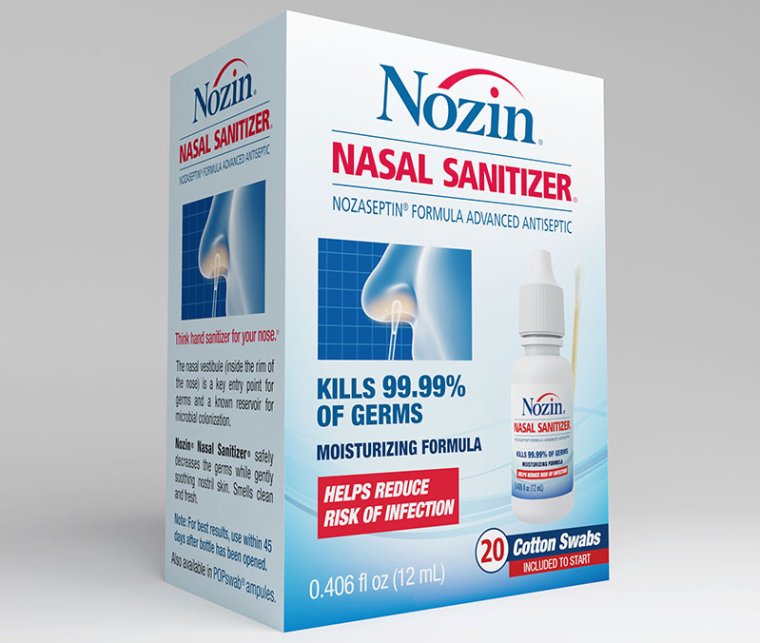
More than four years after SARS-CoV-2 made its global debut, the US Food and Drug Administration is still working to clear out the bogus and unproven products that flooded the market, claiming to prevent, treat, and cure COVID-19.
The latest example is an alcohol-based sanitizer meant to be smeared inside the nostrils. According to its maker, the rub can protect you from becoming infected with SARS-CoV-2 and other nasty germs, like MRSA, and that protection lasts up to 12 hours after each swabbing. That all sounds great, but according to the FDA, none of it is proven. In a warning letter released Tuesday, the agency determined the sanitizer, called Nozin, is an unapproved new drug and misbranded.
While ethyl alcohol is used in common topical antiseptics, like hand sanitizers, the FDA does not generally consider it safe for inside the nostrils—and the agency is unaware of any high-quality clinical data showing the Nozin is safe, let alone effective. The FDA also noted that, for general over-the-counter topical antiseptics, calling out specific pathogens it can fight off—like SARS-CoV-2 and MRSA—is not allowed under agency rules without further FDA review. Making claims about protection duration is also not allowed.
The FDA’s warning letter is nothing to sneeze at; the letter threatens seizure and injunction for failing to adequately respond.
Nozin’s maker, Maryland-based Global Life Technologies Corp., did not immediately respond to a request for comment from Ars. On its website, the company touts its product’s effectiveness with a link to a published study from 2014, indicating that use of Nozin lowered the colonization levels of S. aureus and other bacteria in the noses of 20 healthy health care workers. The study did not address protection from infection or carriage of any viruses. The company also lists unpublished studies indicating that the product can kill bacteria in laboratory conditions, does not irritate skin, and lowered bacterial growth in the noses of 30 people over a 12-hour period.
This is far from the first dubious, nasal-based COVID product the FDA has called out. There was the Corona-cure nasal spray of 2020, and the Halodine and the NanoBio Protect nasal antiseptics of 2021. That year, the Federal Trade Commission sued a company called Xlear over allegedly false claims that its nasal spray can prevent and treat COVID-19. At least two more nasal spray makers received FDA warning letters in 2022.
To date, the FDA has not approved any nasal sprays to prevent or treat COVID-19, and the scant data on their efficacy remains inconclusive. But there are still plenty of such products for sale online. Most, like Nozin, claim to work by killing bacteria and viruses directly. One product, a nitric oxide nasal spray called Sanotize, is currently in a Phase III clinical trial to test whether it can prevent SARS-CoV-2 infections. Others claim to work by coating the nasal passage with the gelling agent iota-carrageenan to provide a barrier to viral entry. A pilot clinical trial of 400 health care workers in Argentina published in 2021 found that the use of an iota-carrageenan nasal spray led to a 4 percent absolute risk reduction in SARS-CoV-2 infection.
Can you sanitize the inside of your nose to prevent COVID? Nope, FDA says. Read More »

Enlarge / Slowly but surely, the Asahi Linux team is getting Linux up and running on Apple Silicon Macs.
Apple/Asahi Linux
For around three years now, the team of independent developers behind the Asahi Linux project has worked to support Linux on Apple Silicon Macs, despite Apple’s total lack of involvement. Over the years, the project has gone from a “highly unstable experiment” to a “surprisingly functional and usable desktop operating system.” Even Linus Torvalds has used it to run Linux on Apple’s hardware.
The team has been steadily improving its open source, standards-conformant GPU driver for the M1 and M2 since releasing them in December 2022, and today, the team crossed an important symbolic milestone: The Asahi driver’s support for the OpenGL and OpenGL ES graphics have officially passed what Apple offers in macOS. The team’s latest graphics driver fully conforms with OpenGL version 4.6 and OpenGL ES version 3.2, the most recent version of either API. Apple’s support in macOS tops out at OpenGL 4.1, announced in July 2010.
Developer Alyssa Rosenzweig wrote a detailed blog post that announced the new driver, which had to pass “over 100,000 tests” to be deemed officially conformant. The team achieved this milestone despite the fact that Apple’s GPUs don’t support some features that would have made implementing these APIs more straightforward.
“Regrettably, the M1 doesn’t map well to any graphics standard newer than OpenGL ES 3.1,” writes Rosenzweig. “While Vulkan makes some of these features optional, the missing features are required to layer DirectX and OpenGL on top. No existing solution on M1 gets past the OpenGL 4.1 feature set… Without hardware support, new features need new tricks. Geometry shaders, tessellation, and transform feedback become compute shaders. Cull distance becomes a transformed interpolated value. Clip control becomes a vertex shader epilogue. The list goes on.”
Now that the Asahi GPU driver supports the latest OpenGL and OpenGL ES standards—released in 2017 and 2015, respectively—the work turns to supporting the low-overhead Vulkan API on Apple’s hardware. Vulkan support in macOS is limited to translation layers like MoltenVK, which translates Vulkan API calls to Metal ones that the hardware and OS can understand.
Apple’s OpenGL support has been stuck at the 4.1 level since macOS 10.9 Mavericks was released in 2013. Since then, the company has shifted its focus to its proprietary Metal graphics API, which, like DirectX 12 and Vulkan, is a “low-overhead” API meant to reduce the performance overhead sometimes associated with older APIs like OpenGL. But despite declaring OpenGL officially deprecated in 2018, Apple has left its existing OpenGL implementation alone since then, never updating it but also maintaining support even as it has transitioned from Intel’s processors to its own CPUs and GPUs.
Rosenzweig’s blog post didn’t give any specific updates on Vulkan except to say that the team was “well on the road” to supporting it. In addition to supporting native Linux apps, supporting more graphics APIs in Asahi will allow the operating system to take better advantage of software like Valve’s Proton, which already has a few games written for x86-based Windows PCs running on Arm-based Apple hardware.
Though there are still things that don’t work, Fedora Asahi Remix is surprisingly polished and supports a lot of the hardware available in most M1 and M2 Macs—including the webcam, speakers, Wi-Fi and Bluetooth, and graphics acceleration. Other features, like Thunderbolt, running displays over USB-C, the system’s built-in microphone, and the Touch ID fingerprint sensors, remain non-functional. Asahi’s most recent update blog post, published in mid-January, highlighted HDMI support, support for DRM-protected websites via Google’s proprietary Widevine package, Touchbar support for the handful of Apple Silicon Macs that use one, and more.
As for the newest wave of M3 Macs, Asahi developer Hector Martin said in October 2023 that basic support for the newest chips would take “at least six months.” Among other things, the team will need time to support the M3 GPU in their drivers; the team also relies primarily on Mac mini models for development, and the M3 Mac mini doesn’t exist yet.
Asahi Linux project’s OpenGL support on Apple Silicon officially surpasses Apple’s Read More »